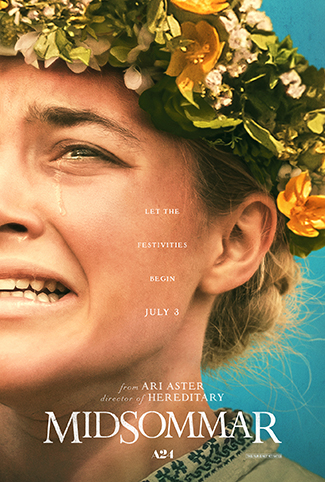For a wholesome paean to Nordic rituals, do not watch Ari Aster’s Midsommar

Emily C. Skaftun
The Norwegian American
As we entered the theater, my friend asked me what I knew about Midsommar. “It’s Swedish…” I answered. I’d heard little about the movie, enough to guess it wasn’t a comedy, but not enough to be fully prepared.
The first thing I have to tell you, readers of The Norwegian American, is that this movie is not for the faint of heart. It is at times graphic in its depictions of both violence and sex. After watching it I looked up the rating and was surprised to discover it was only R-rated. Don’t be fooled by the title! This is not some benign romp around a maypole.
The music alone is enough to hammer that message home—it’s probably untrue that the soundtrack comprised a single drawn-out drone, but that’s how it felt to me. After two and a half hours of it, I felt physically tired.
The movie’s central character is American grad student Dani (Florence Pugh), who starts out feeling powerless and alone, unable to reach her family after receiving a disturbing message from her bipolar sister. For comfort, she calls her boyfriend, Christian (Jack Reynor), who minimizes Dani’s concerns. He’s been wanting to dump her for a year.
But Dani’s worry was, if anything, not strong enough; her family is all dead. Her trauma is one of the most powerfully rendered aspects of this film—the mere mention of the word “family” can send her into a panic, even months later.
The night her family dies, Christian holds Dani while she wails, but his heart isn’t in it. He doesn’t even tell her about his planned trip to Sweden to observe the Midsommar rituals of their friend Pelle’s hometown commune* until two weeks before they leave, at which point he invites her along out of guilt, to the eyerolls of his horrible friends.
*Don’t let whatever knowledge of Nordic languages you may have fool you into believing this is an innocent word for “town” or “municipality;” it isn’t.
According to Midsommar’s writer and director, Ari Aster, the film is really about breakups, and that comes across loud and clear. As you watch this film, you may be primarily horrified by the horrific things happening, but on reflection I find the grim and accurate portrayal of a dying relationship to be in many ways scarier.
Pelle (Vilhelm Blomgren), not Christian, is the only one of the dudes who’s happy to have her along. He seems as different from the reluctant boyfriend as can be: supportive, gentle, kind-eyed. Pelle explains his town to Dani by telling her that his parents died when he was very young, making him “technically an orphan.” Yet because of the way his town shares everything (and I mean everything, from sleeping quarters to meal preparation to a teenage girl’s deflowering), he “always felt held.” He contrasts this to her utter aloneness, and more pointedly to Christian: “Do you feel held by him? Does he feel like home to you?”
The movie, of course, takes extreme liberty with pagan customs that may or may not have once been practiced in Scandinavia, for dramatic effect. The visitors are greeted with hallucinogens, a mushroom tea used many times throughout the film (and the visual effects employed to render that altered state are, in my opinion, one of the more impressive cinematographic achievements in this visually stunning film). Runic writing is used by the villagers, as are what can only be described as magic charms. There is, of course, a maypole—which looks exactly like you think it should—with an entirely believable rationale for its dance-till-you-drop ritual used to elect a May Queen.
But the one that leaps out the most is ättestupa, which occurs early in this year’s special nine-day Midsommar ritual, which occurs every 90 years. Pelle tells his friends that an ättestupa will occur, but only the most studious of them knows the word, and he keeps his mouth shut. He asks Pelle if it’s symbolic, and Pelle replies, “It’s pretty real.”
Ättestupa is a probably apocryphal concept from Nordic folklore, particularly in Sweden, that is probably enjoying a surge in google searches (Christian tries to google it, but predictably his phone has no signal), and I will let you spoil it for yourself if you so choose and not define the term here. Even if, like me, you’d never heard of it before, there’s plenty of context to get you up to speed ahead of our hapless characters.
It’s no coincidence that at least two of the visiting Americans are anthropology students, there in part to study and write about the strange customs of this exotic tribe. This goes as badly for them as you might expect, especially for a character named “Christian.”
With how extreme the Midsommar rituals are, one wonders what the village does to mark the winter solstice.
Happily, things go better for Dani than I’d dared hope. As strange and even murderous as this community is, it gives her something she desperately needs—family. For better or worse, the members of this community feel each other’s pain and are there to hold each other.
Emily C. Skaftun became editor of The Norwegian American in Jan. 2014, and has been attempting to learn Norwegian ever since (hun snakker bare litt norsk). In her spare time Emily plays roller derby and writes science fiction and fantasy stories. You can find links to many of them at www.ecskaftun.com.
This article originally appeared in the July 26, 2019, issue of The Norwegian American. To subscribe, visit SUBSCRIBE or call us at (206) 784-4617.
